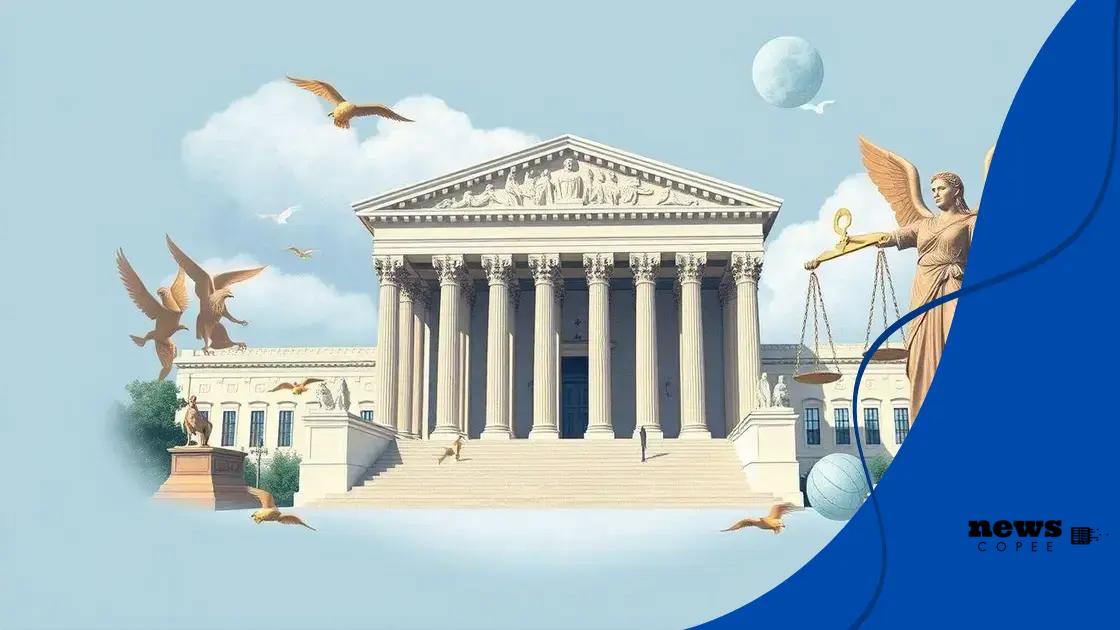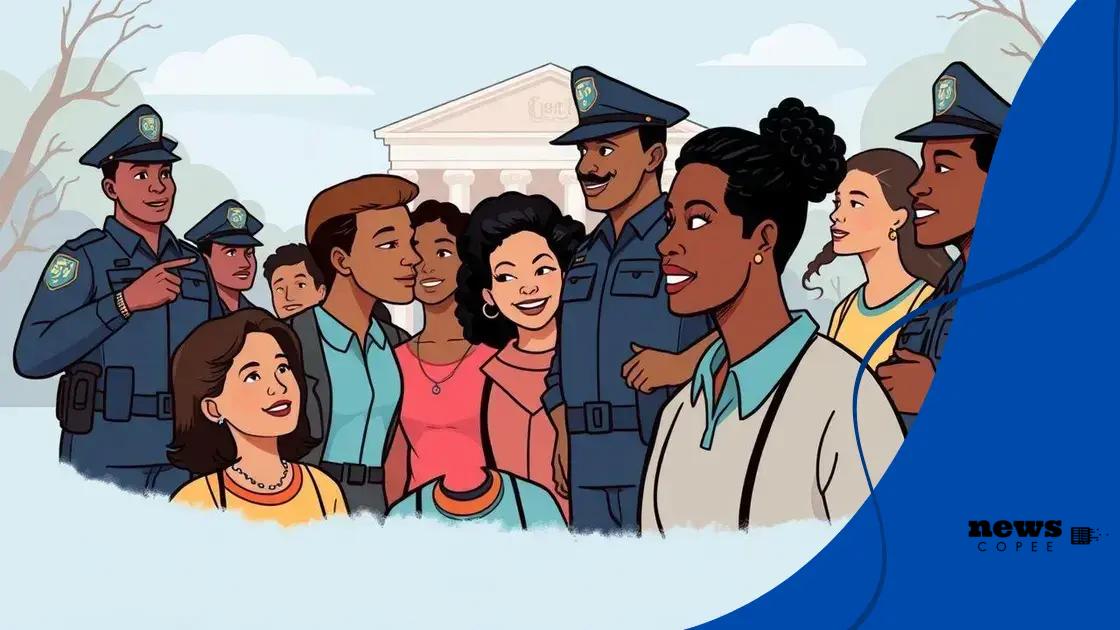Supreme Court decisions in May 2025 announced

Supreme Court decisions in May 2025 have brought significant changes in civil rights, environmental law, and healthcare regulations, emphasizing equity, sustainability, and improved access to essential services.
Supreme Court decisions in May 2025 announced promise to bring significant changes to various legal aspects. Have you considered how these rulings could affect you? Let’s delve into the details.
Key decisions impacting civil rights
One of the most significant areas affected by the recent Supreme Court decisions in May 2025 is civil rights. These rulings may reshape existing laws and set new precedents for the future. Understanding these decisions is crucial for advocates and citizens alike.
Recent Important Rulings
The court has delivered several key judgments that directly impact civil rights. For example, the ruling on voting rights could change how states implement regulations. This can lead to greater access for some and restrictions for others.
- Voting Rights: New laws affecting voter registration processes.
- Equal Treatment: Cases addressing discrimination based on gender and race.
- Disabilities Act: Changes in protections for individuals with disabilities.
Additionally, rulings on free speech and assembly could influence how protests and demonstrations are conducted. These changes may either strengthen or weaken the protections afforded to individuals under the First Amendment.
Implications for Advocacy Groups
With these decisions in play, advocacy groups must adapt their strategies. It’s important for them to stay informed about legal interpretations that could alter their operations. As these groups rally for change, they may need to focus on new areas of concern raised by the court’s actions.
Monitoring developments in civil rights laws will be vital for advocates. By staying updated, they can better engage in discussions and actions that promote equality and justice in society. The evolving nature of these laws requires constant vigilance from organizations fighting for civil liberties.
Major rulings in environmental law
Recent Supreme Court decisions in May 2025 have made significant impacts in the field of environmental law. These rulings highlight the ongoing conflict between development and environmental protection. Understanding these changes can help individuals and organizations navigate the new regulatory landscape effectively.
Key Rulings on Pollution Control
The court has tackled important cases related to pollution control, focusing on emissions and regulatory authority. One landmark ruling has clarified the extent of federal power in regulating greenhouse gas emissions from major industries.
- Greenhouse Gas Standards: New standards set for industrial emissions.
- State Authority: States granted more power to enforce their environmental regulations.
- Public Health Considerations: Decisions must evaluate the health impacts of pollutants.
Further, rulings addressing land use regulations have emerged, affecting how land can be developed while still conserving vital ecosystems. These decisions reflect a growing awareness of the balance required for sustainable development.
Influence on Renewable Energy Policies
Several major rulings are aimed at encouraging renewable energy usage. The Supreme Court’s support for renewable projects indicates a strong push towards sustainable energy solutions. Legal frameworks are now more favorable for solar and wind energy initiatives.
This shift could lead to significant investment opportunities in green technologies. Additionally, these changes encourage local governments and private sectors to invest in clean energy sources that meet the increasing demand for sustainability.
Changes in criminal justice policies

The recent Supreme Court decisions in May 2025 have introduced significant changes in criminal justice policies. These rulings aim to address various issues, such as sentencing guidelines, police practices, and inmates’ rights. Understanding these changes is essential for anyone interested in the criminal justice system.
New Sentencing Guidelines
One major ruling focuses on updating sentencing guidelines. This decision impacts how judges determine sentences for various crimes. By emphasizing rehabilitation, the court is shaping a more balanced approach to punishment.
- Reducing Mandatory Minimums: Limits on harsh sentences for non-violent offenses.
- Focus on Rehabilitation: Incentives for programs that help offenders reintegrate into society.
- Judicial Discretion: More power given to judges to consider individual circumstances.
As the laws evolve, many are hopeful this will decrease prison overcrowding and reduce recidivism rates. This transition reflects a broader understanding of criminal justice beyond mere punishment.
Impact on Police Practices
Another important area of change is in police practices and accountability measures. Rulings have set new standards for law enforcement, aiming to protect citizens’ rights while maintaining public safety.
Increased transparency and accountability are now essential components of police work. This involves better training for officers on interactions with the community and clearer guidelines for the use of force.
Communities are also advocating for stronger oversight of police departments. These changes indicate a significant shift towards reforming policing methods to ensure that all individuals are treated fairly, regardless of their background.
Implications for healthcare regulations
The recent Supreme Court decisions in May 2025 have significant implications for healthcare regulations. These rulings affect various aspects of healthcare, such as access to services, insurance policies, and patient rights. Understanding these changes is crucial for both providers and consumers.
Access to Healthcare Services
One major impact stems from rulings aimed at improving access to healthcare services. The court has emphasized the importance of making medical care available to all individuals, regardless of their circumstances.
- Insurance Coverage: Expanded requirements for insurance plans to cover essential health services.
- Telehealth Services: Legal support for the expansion of telehealth options, making care more accessible.
- Community Health Programs: Increased funding for programs that target underserved areas.
These changes aim to eliminate barriers that previously hindered access to necessary care. Patients can expect more opportunities to receive treatment, especially in rural and low-income regions.
Patient Rights and Protections
Another significant aspect influenced by the Supreme Court’s decisions is patient rights. The court’s rulings enhance consumer protections, ensuring patients are treated fairly by healthcare providers.
Stronger regulations surrounding transparency in medical billing are now in place. Patients will have a clearer understanding of their costs, which can lead to more informed decisions about their healthcare.
Furthermore, these rulings focus on protecting patient privacy, ensuring that personal health information is kept confidential and secure. This emphasis on patient rights is vital in building trust between providers and patients.
Future trends in Supreme Court reasoning
The future trends in Supreme Court reasoning are shaping how justice is interpreted in America. Recent rulings show the court adapting to societal changes and emerging legal standards. Observing these trends helps us understand how the court may address upcoming cases.
Impact of Technology on Legal Decisions
One significant trend is the influence of technology on legal reasoning. The court increasingly deals with cases involving digital privacy and cybersecurity. As technology evolves, so too does the legal framework surrounding it.
- Data Privacy: New cases will likely address how personal data is collected and used.
- Cybersecurity Laws: Legal standards for protecting information will become crucial.
- Digital Freedoms: Issues surrounding free speech online are on the rise.
These technological advancements lead the court to reconsider old laws and create new interpretations reflecting current realities.
Growing Emphasis on Social Justice
Another trend is the court’s growing focus on social justice issues. Recent rulings have highlighted the importance of equity and fairness in the legal system. This evolution indicates a shift towards a more inclusive interpretation of rights.
As public sentiment shifts toward greater equality, the court may embrace rulings that reflect these values. This can include decisions related to civil rights, healthcare, and education.
Engagement from the public also plays a role in shaping the court’s priorities. Advocacy groups are increasingly impacting how the court approaches key issues, leading to a more dynamic legal landscape.
In summary, the Supreme Court decisions in May 2025 will significantly influence various areas such as civil rights, environmental law, and healthcare regulations. The new trends indicate a shift towards more inclusive and equitable legal reasoning, particularly as public engagement grows. Understanding these rulings is essential for anyone impacted by the legal system, as they represent changes that could shape the future of justice in America.
\n\n\n
| Topics 📜 | Details 💡 |
|---|---|
| Civil Rights | Continued focus on equity and fair treatment. ✊ |
| Environmental Law | New rulings to enhance sustainability efforts. 🌍 |
| Healthcare Regulations | Improved access and patient rights protections. 🏥 |
| Technological Influence | Increased legal focus on digital privacy and rights. 💻 |
| Public Engagement | Growing activism shaping court decisions and priorities. 📢 |
\n
\n
FAQ – Frequently Asked Questions about Supreme Court Decisions in May 2025
What are the key changes in civil rights as a result of the recent Supreme Court decisions?
The recent decisions have emphasized equity and fairness, potentially strengthening protections against discrimination.
How do the rulings impact environmental law?
The Supreme Court has introduced new regulations aimed at enhancing sustainability and protecting natural resources.
What improvements are being made in healthcare regulations?
The rulings enhance access to healthcare services and strengthen patient rights, ensuring better care for all.
How is technology influencing legal decisions?
The court is increasingly addressing issues related to digital privacy and cybersecurity, adapting laws to current technological landscapes.
